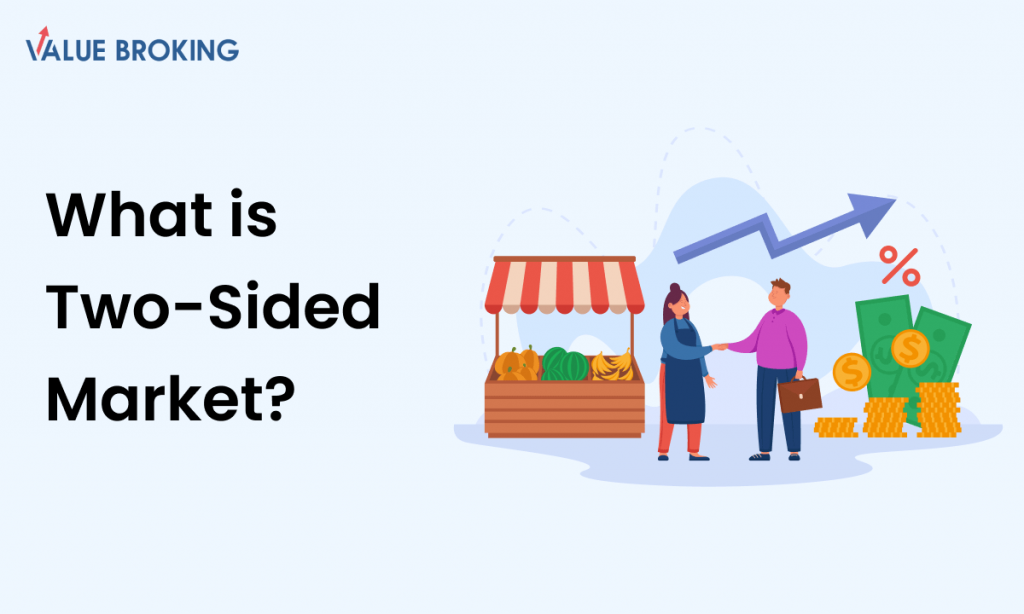What is Two-Sided Market?

A two-sided market or two-sided network can be any marketplace that involves both buyers and sellers coming together through an intermediary or platform. For example, there are two parties in the stock market, the buying party and the selling party. The buying parties place bids for the various stocks or other financial securities trading in the stock market. Whereas the sellers ask or demand a price at which they will be willing to sell those stocks or securities. Both the buying and the selling parties connect and carry out transactions through the exchange. Hence, the stock market is also two-sided, having both buyers and sellers connected through the exchange, which is the intermediary. To understand a two-sided market in detail, let’s understand its examples.
Table of Contents
Two-Sided Market Examples
Two-sided networks also exist across different industries apart from the stock market. They cater to the interests of different individuals or groups like retailers, manufacturers, and consumers. For example, when it comes to credit card services, the credit card company is the intermediary. Here enough consumers are willing to use credit cards to make payments, so retailers and service providers accept credit card payments.
Similarly, an ecommerce platform like Amazon is a two-sided marketplace. Here the ecommerce platform acts as the intermediary that connects customers to different merchants selling their products. Finally, a social media website or platform is also a two-sided network. Here people connect to the network, consuming content and come across advertisements. Such advertisements are promoted on the platform by advertisers.
Functioning of a Two-Sided Market
Any two-sided network will function smoothly if the structure and design of the market allow the number of participants in the market to increase without any compromise. At the same time, a two-sided network should be able to attract and retain members of both parties. It can do this through quick, easy and smooth transactions. If one side does not see value or potential in the market to satisfy their requirements, the market will fail.
In the case of credit card companies, They offer customers several incentives to use their credit card services. They offer higher credit limits, leading to more purchasing power and rewards. Customers also find a credit card payment process more convenient than writing a cheque. On the other hand, service providers choose to accept credit card payments as they notice that the demand to make payments through credit cards is high. So customers using credit cards see the benefits of using credit cards. At the same time, retailers and service providers can see a rise in sales by accepting payments through credit cards.
Two-Sided Market and Securities Trading
In the case of the stock market, there is no limitation on the number of people allowed entry into the stock market. However, when physical trading was the predominant trading method, the stock market was not very accessible to retail investors. However, now all one needs is a Demat account, for which they need to have a PAN card, and then they are eligible to trade in the stock market. In the stock market, both buyers and sellers trade or invest in stocks and other financial securities to make profits. For which the buyer would want a seamless purchase transaction when they place a reasonable bid. Likewise, a seller selling their stocks would only receive satisfaction when a buyer purchases the stocks for the given task or selling price.
The exchange that acts as the intermediary needs to maintain an equilibrium between both parties. In simple words, it should have the potential to satisfy the requirements of both buyers and sellers. Only then it will be able to attract and retain members from both the buying and selling parties. Moreover, the exchange has to execute the orders placed by buyers and sellers as quickly as possible for a smooth transaction process. The market makers help carry out those mentioned above by maintaining liquidity in the markets.
Market makers accept the bids and the asks sent to the exchange by retail investors and traders. Market makers will buy and sell stocks and other securities so that the stock or security always remains liquid. When an asset is liquid, it gets converted into cash instantly. In the absence of the market makers, one would not experience a seamless order execution if they placed a market order. A scenario could also arise where one party overwhelms the other. This scenario would put an end to a two-sided network. If the Indian stock market had only sellers selling stocks and no buyers present, the sellers would find another market.
Conclusion
A two-sided network may encompass markets from different domains, provided they show certain characteristics and features.
- Firstly, a two-sided network has to connect buyers and sellers through an intermediary.
- Both buyers and sellers should have an incentive to participate in the market to carry out trades. For which the market should have the potential to satisfy those incentives of both the parties.
- A two-sided network should grow by attracting more participants and retaining existing ones.
- Lastly, there should be an equilibrium between both the participants.
The stock market shows the above features and qualifies as a two-sided network. Likewise, other financial markets like the bond markets, derivative markets and currency markets are also two-sided. We hope, through this article, you have understood what a two-sided network is and how the stock market qualifies as a two-sided network.
Frequently Asked Questions (FAQs)
A two-way quote shows both the current bid prices and the current ask prices of a stock or financial security during a trading day on the exchange.
Websites such as Fiverr, Airbnb, eBay, Uber, etc., actively participate in two-sided marketplaces to create and exchange value.
A healthy two-sided network is a place where you can sell a popular stock, mutual fund, etc., in no time.